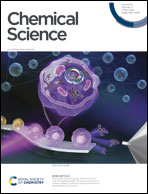Electrocatalytic CO2 reduction to formate by a cobalt phosphino–thiolate complex†
Abstract
Electrochemical conversion of CO2 to value-added products serves as an attractive method to store renewable energy as energy-dense fuels. Selectivity in this type of conversion can be limited, often leading to the formation of side products such as H2. The activity of a cobalt phosphino–thiolate complex ([Co(triphos)(bdt)]+) towards the selective reduction of CO2 to formate is explored in this report. In the presence of H2O, selective production of formate (as high as 94%) is observed at overpotentials of 750 mV, displaying negligible current degradation during long-term electrolysis experiments ranging as long as 24 hours. Chemical reduction studies of [Co(triphos)(bdt)]+ indicates deligation of the apical phosphine moiety is likely before catalysis. Computational and experimental results suggest a metal-hydride pathway, indicating an ECEC based mechanism.

- This article is part of the themed collection: Most popular 2024 catalysis articles


 Please wait while we load your content...
Please wait while we load your content...